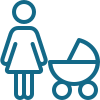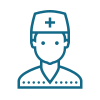Nursing care for Esophageal Cancer
Any form of cancer is morally unpleasant, and at this time, people would prefer to be with and supported by their loved ones over being in a hospital. In this way, Medintu offers the best at-home treatment for esophageal cancer. Esophageal cancer nurses have specialised training in providing caring esophageal cancer care. Therefore, if you need to receive esophageal cancer therapy at home, you may count on us for quality medical attention, esophageal cancer nurses, and therapeutic support. Give us a call so that we can provide the greatest care for your loved one while keeping you at home.

Fill out form to enquire now
What is Esophageal Cancer?
The oesophagus, the muscular tube that connects the throat to the stomach, is where esophageal cancer typically begins. Chest pain, weight loss, difficulty swallowing, and chronic coughing are all symptoms. Typically, an endoscopy is used to diagnose it, and surgery, radiation treatment, and/or chemotherapy are used to treat it.
Esophageal Cancer Types
- Esophageal squamous-cell carcinoma –It is formed by epithelial cells that line the esophagus. It is mostly caused by the use of alcohol, betel nuts, cigarettes, and a bad diet.
- Esophageal Adenocarcinoma – This kind of esophageal cancer develops from glandular cells in the bottom portion of the esophagus. Tobacco usage, obesity, and acid reflux are all risk factors for this kind of cancer.
Small cell carcinoma, sarcoma, lymphoma, melanoma, and choriocarcinoma are all rare kinds of esophageal cancer.
Esophageal Cancer Stages
Esophageal cancer stages aid in assessing the extent and size of cancer, the extent of tumor invasion, lymph node involvement, and distant metastases. Doctors utilize a variety of staging systems to define esophageal cancer stages, and this staging method also helps them decide on the best course of therapy for the patient.
The esophageal cancer stages are divided into four categories, with stage 0 indicating that the disease is restricted to the superficial layer of the esophagus and stage IV showing that cancer has spread to other parts of the body.
Services Offered
Esophageal Cancer Symptoms
Because the development of the symptoms is prompted by the narrowing of the esophageal tube, the principal esophageal cancer symptoms are not obvious until the cancer has spread to more than 60% of the esophageal tube, and by that time, the tumor has progressed. Here are some of the most prevalent esophageal cancer symptoms:
Swallowing Difficulties
Acid reflux and heartburn
Pain behind the breastbone and in the abdomen
Vomiting and nausea
Fistulas
Unintentional weight loss
Aspiration Pneumonia
Esophagael Cancer Causes
The major cause of esophageal cancer is a mutation in the esophageal cells that allows them to proliferate and divide uncontrollably. The exact reason why the cells begin to behave in this strange manner is unknown. A few risk factors for esophageal cancer have been found, and they are as follows:
Betel nut chewing
Tobacco smoking
Consumption of alcoholic beverages
Poor nutrition and way of life
Reflux of acid
Obesity
Esophageal Cancer Diagnosis
- The following are the different esophageal cancer diagnostic tests and techniques used in esophageal cancer diagnosis:
- Endoscopy was the first esophageal cancer diagnostic technique employed. It aids in the examination of the esophagus to detect malignant development and regions of inflammation.
- A Biopsy is the second esophageal cancer test employed, in which a sample of tissue from the esophagus is obtained and submitted for testing.
- Endoscopic ultrasound, PET scanning, and CT scanning are some of the additional esophageal cancer screening techniques utilized in addition to the ones listed above.
Esophageal Cancer Home Treatment
Home treatment for esophageal cancer includes herbal medicine, dietary adjustments, and esophageal cancer care. Here are a few of the methods that may be used as part of esophageal cancer home treatment:
- To relieve nausea, drink caffeine-free and clear liquids such as tea, ginger ale, and lemonade.
- Consume plenty of calories from creamy calorie-rich foods such as creams and sauces, ice cream, and avocados to avoid weight loss.
- To numb the throat, avoid hot liquids and instead choose cooler food products such as milk shakes, smoothies, ice cream, gelatos, and so on.
- Consume modest portions and chew thoroughly.
- Experiment with various relaxation techniques such as yoga, acupuncture, and deep breathing.
Esophageal Cancer Treatment
Early discovery is important for esophageal cancer therapy, but the condition is not totally curable since, by the time symptoms appear, cancer has progressed. Nonetheless, as esophageal cancer treatment advances, the illness is better treated and relief is delivered through surgery, chemotherapy, and radiation therapy.
Surgery can help remove extremely tiny tumors or remove a part of the esophageal (esophagectomy) or remove a portion of the esophagus together with the upper region of the stomach (esophagogastrectomy).
Chemotherapy is the use of chemical medications to destroy cancer cells in the treatment of esophageal cancer.
Radiation treatment kills cancer cells by using high-powered radiation beams or proton beams. Sometimes
Just Fill Up The Form We'll Take Care Of The Rest!
Services Available in India
Need Help?
FAQs
What are the causes of esophageal cancer risk factors?
The causes of esophageal cancer risk factors are age and gender are factors that affect esophageal cancer risk, Compared to women, men are more prone to develop esophageal cancer, Alcohol and tobacco, Barrett’s oesophagus, obesity, diet, physical activity, and gastroesophageal reflux disease.
How many phases are there in esophageal cancer?
Stage 0 refers to the very early stages of esophageal cancer (high grade dysplasia). Stage I (1) to stage IV are then included (4). The less the number, generally speaking, the less the cancer has spread. A higher number, such stage IV, denotes that the cancer has progressed more widely.
Where does esophageal cancer begin to spread?
In particular, esophageal cancer starts in the inner layer of the esophageal wall and spreads outward. The tiny, bean-shaped structures that help fight infection, the lymph nodes, as well as the blood arteries in the chest and other adjacent organs, can all be affected if it penetrates the oesophagus wall and spreads.












